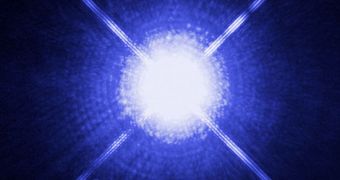According to a new theory, blue stragglers, which are massive rogue stars within clusters numbering up to 100,000 stars, are created through a process known as stellar cannibalism. This process occurs mostly in binary systems, and grows in intensity when the stars begin devouring each other. Normally, in these systems, the two stars are spinning around each other, and do not collide. But if one is stronger, then the other will be consumed, and a blue straggler will be born.
A young star always shines blue, as far as astronomers know, but figuring out why older stars keep shining blue was virtually impossible for researchers until now. Based on images of the 47 Tucanae globular cluster, captured using Hubble Space Telescope's Wide Field and Planetary Camera 2, they came to believe that stragglers are actually "rejuvenated stars," which are formed either by the soft merger of the two components of a binary system, or by the collision of two unrelated stars.
"We've known of these star abnormalities for 55 years now. Over time two main theories have emerged: that blue stragglers were created through collisions with other stars; or that one star in a binary system was 'reborn' by pulling matter off its companion," explains McMaster University Department of Physics & Astronomy associate professor, Alison Sills.
On account of the fact that the pictures captured by Hubble showed the example of a large agglomeration of stars in which blue stragglers are very common, the astronomers have concluded that stellar cannibalism has to be the mechanism by which these weird and unusual celestial bodies are born. Any other phenomenon wouldn't account for the large number of blue stars that can be found in 47 Tucanae.
"This is the strongest and most direct evidence to date that most blue stragglers, even those found in the cluster cores, are the offspring of two stars transferring matter. In our future work we will want to determine whether the binary parents of blue stragglers evolve mostly in isolation, or whether dynamical encounters with other stars in the clusters are required somewhere along the line in order to explain our results," concludes Southampton University School of Physics and Astronomy Reader, Christian Knigge, who also worked with Sills in the research.

 14 DAY TRIAL //
14 DAY TRIAL //